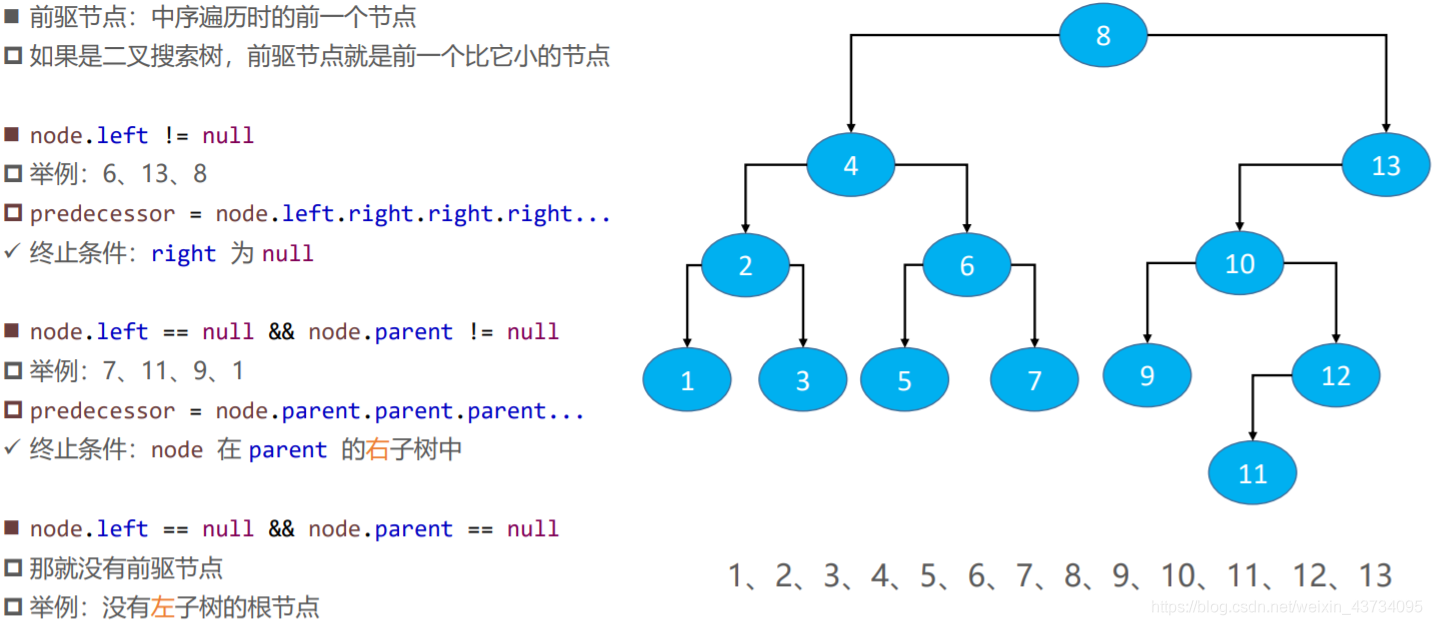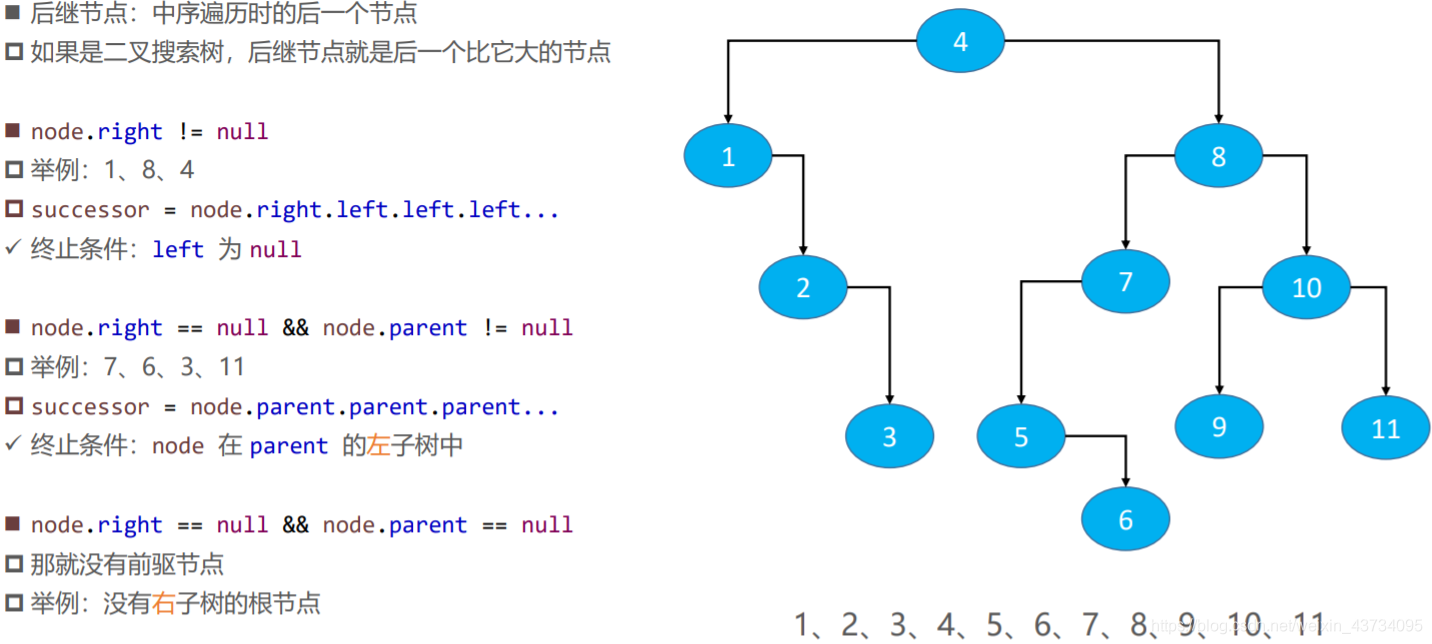《恋上数据结构第 1 季》二叉树代码实现,mongodb 持久化原理
// 根
if (visitor.stop) return;
visitor.stop = visitor.visit(node.element);
// 右
inorder(node.right, visitor);
}
/**
后序遍历(递归)
*/
public void postorder(Visitor<E> visitor) {
if (visitor == null) return;
postorder(root, visitor);
}
public void postorder(Node<E> node, Visitor<E> visitor) {
if (node == null || visitor.stop) return;
// 左
postorder(node.left, visitor);
// 右
postorder(node.right, visitor);
// 根
if (visitor.stop) return;
visitor.stop = visitor.visit(node.element);
}
/**
层次遍历(队列)
*/
public void levelOrder(Visitor<E> visitor){
if(root == null || visitor.stop) return;
Queue<Node<E>> queue = new LinkedList<>(); // 队列
queue.offer(root);
while(!queue.isEmpty()){
Node<E> node = queue.poll();
if(visitor.visit(node.element)) return;
if(node.left != null) {
queue.offer(node.left);
}
if(node.right != null) {
queue.offer(node.right);
}
}
}
====================================================================================
/**
求树的高度(递归)
*/
public int height() {
return height(root);
}
public int height(Node<E> node) {
if (node == null) return 0;
return 1 + Math.max(height(node.left), height(node.right));
}
/**
求树的高度高度(迭代)
*/
public int height() {
if (root == null) return 0;
// 存储每一层的元素数量, root!=null, 则首层必然有 1 个元素
int levelSize = 1;
int height = 0; // 树的高度
Queue<Node<E>> queue = new LinkedList<>();
queue.offer(root);
while (!queue.isEmpty()) {
Node<E> node = queue.poll();
levelSize--;
if (node.left != null) {
queue.offer(node.left);
}
if (node.right != null) {
queue.offer(node.right);
}
if (levelSize == 0) { // 即将要访问下一层
levelSize = queue.size(); // 下一层的元素数量
height++;
}
}
return height;
}
==========================================================================================
/**
是否是完全二叉树
*/
public boolean isComplete() {
if (root == null) return false;
Queue<Node<E>> queue = new LinkedList<>();
queue.offer(root);
// leaf 代表是否要求后面都是叶子节点
// 比如遍历到一个节点 left == null && right == null
// 或者是 left != null && right == null
// 则要求这个节点后面的节点都是叶子节点
boolean leaf = false;
while (!queue.isEmpty()) {
Node<E> node = queue.poll();
// 要求是叶子结点,但是当前节点不是叶子结点
if (leaf && !node.isLeaf()) {
return false;
}
if (node.left != null) {
queue.offer(node.left);
} else if (node.right != null) {
// node.left == null && node.right != null
return false;
}
if (node.right != null) {
queue.offer(node.right);
} else {
// node.left == null && node.right == null
// node.left != null && node.right == null
leaf = true; // 要求后面都是叶子节点
}
}
return true;
}
==========================================================================

/**
前驱节点: 中序遍历时的前一个节点
求前驱节点
*/
protected Node<E> predecessor(Node<E> node) {
if (node == null) return null;
// 前驱节点在左子树中(left.right.right.right....)
Node<E> p = node.left;
if (p != null) {
// 左子树不为空,则找到它的最右节点
while (p.right != null) {
p = p.right;
}
return p;
}
// 能来到这里说明左子树为空, 则从父节点、祖父节点中寻找前驱节点
// 当父节点不为空, 且某节点为父节点的左子节点
// 则顺着父节点找, 直到找到【某结点为父节点或祖父节点的右子树中】时
while (node.parent != null && node.parent.left == node) {
node = node.parent;
}
// 来到这里有以下两种情况:
// node.parent == null 无前驱, 说明是根结点
// node.parent...right == node 找到【某结点为父节点或祖父节点的右子树中】
// 那么父节点就是某节点的前驱节点
return node.parent;
}

/**
后继节点: 中序遍历时的后一个节点
求后继节点
*/
protected Node<E> successor(Node<E> node) {
if (node == null) return null;
// 后继节点与前驱节点正好相反
// 后继节点在右子树中(node.right.left.left...)
if (node.right != null) {
Node<E> p = node.right;
while (p.left != null) {
p = p.left;
}
return p;
}
// 来到这里说明没有右节点, 则从父节点、祖父节点中寻找后继节点
// 当父节点不为空, 且某节点为父节点的右子节点
// 则顺着父节点找, 直到找到【某结点在父节点或祖父节点的左子树中】时
while (node.parent != null && node.parent.right == node) {
node = node.parent;
}
// 来到这里有以下两种情况:
// node.parent == null 无前驱,说明是根结点
// node.parent.left == node 找到【某结点在父节点或祖父节点的左子树中】
// 那么父节点就是某节点的后继节点
return node.parent;
}
====================================================================================
这是 MJ 老师自己写的一款工具,可以方便的打印二叉树,git 地址如下:https://github.com/CoderMJLee/BinaryTrees。
/**
BinaryTreeInfo 工具,用来打印二叉树
*/
@Override
public Object root() {
return root;
}
@Override
public Object left(Object node) {
return ((Node<E>)node).left;
}
@Override
public Object right(Object node) {
return ((Node<E>)node).right;
}
@Override
public Object string(Object node) {
Node<E> myNode = (Node<E>)node;
String parentStr = "null";
if(myNode.parent != null){
parentStr = myNode.parent.element.toString();
}
return myNode.element + "_p(" + parentStr + ")";
}
==========================================================================
package com.mj.tree;
import java.util.LinkedList;
import java.util.Queue;
import com.mj.printer.BinaryTreeInfo;
/**
二叉树(通用)
*/
@SuppressWarnings("unchecked")
// 实现 BinaryTreeInfo 接口是为了使用打印二叉树的工具,非必须
public class BinaryTree<E> implements BinaryTreeInfo {
protected int size; // 元素数量
protected Node<E> root; // 根节点
/**
访问器接口 ——> 访问器抽象类
增强遍历接口
*/
/*public static interface Visitor<E>{
void visit(E element);
}*/
public static abstract class Visitor<E> {
boolean stop;
// 如果返回 true,就代表停止遍历
public abstract boolean visit(E element);
}
/**
内部类,节点类
*/
public static class Node<E> {
E element; // 元素值
Node<E> left; // 左节点
Node<E> right; // 右节点
Node<E> parent; // 父节点
public Node(E element, Node<E> parent) {
this.element = element;
this.parent = parent;
}
public boolean isLeaf() { // 是否叶子节点
return left == null && right == null;
}
public boolean hasTwoChildren() { // 是否有两个子节点
return left != null && right != null;
}
public boolean isLeftChild(){ // 判断自己是不是左子树
return parent!=null && this==parent.left;
}
public boolean isRightChild(){ // 判断自己是不是右子树
return parent!=null && this==parent.right;
}
/*
返回兄弟节点
*/
public Node<E> sibling() { // 红黑树中用到, 返回兄弟节点
if (isLeftChild()) {
return parent.right;
}
if (isRightChild()) {
return parent.left;
}
return null;
}
}
/**
元素的数量
*/
public int size() {
return size;
}
/**
是否为空
*/
public boolean isEmpty() {
return size == 0;
}
/**
清空所有的元素
*/
public void clear() {
root = null;
size = 0;
}
/**
前序遍历
*/
public void preorder(Visitor<E> visitor) {
if (visitor == null) return;
preorder(root, visitor);
}
public void preorder(Node<E> node, Visitor<E> visitor) {
if (node == null || visitor.stop) return;
// 根
visitor.stop = visitor.visit(node.element);
// 左
preorder(node.left, visitor);
// 右
preorder(node.right, visitor);
}
/**
中序遍历
*/
public void inorder(Visitor<E> visitor) {
if (visitor == null) return;
inorder(root, visitor);
}
public void inorder(Node<E> node, Visitor<E> visitor) {
if (node == null || visitor.stop) return;
// 左
inorder(node.left, visitor);
// 根
if (visitor.stop) return;
visitor.stop = visitor.visit(node.element);
// 右
inorder(node.right, visitor);
}
/**
后序遍历
*/
public void postorder(Visitor<E> visitor) {
if (visitor == null) return;
postorder(root, visitor);
}
public void postorder(Node<E> node, Visitor<E> visitor) {
if (node == null || visitor.stop) return;
// 左
postorder(node.left, visitor);
// 右
postorder(node.right, visitor);
// 根
if (visitor.stop) return;
visitor.stop = visitor.visit(node.element);
}
/**
层次遍历
*/
public void levelOrder(Visitor<E> visitor) {
if (root == null || visitor.stop) return;
Queue<Node<E>> queue = new LinkedList<>(); // 队列
queue.offer(root);
while (!queue.isEmpty()) {
Node<E> node = queue.poll();
if (visitor.visit(node.element)) return;
if (node.left != null) {
queue.offer(node.left);
}
if (node.right != null) {
queue.offer(node.right);
}
}
}
/**
求树的高度(递归)
*/
public int height1() {
return height1(root);
}
public int height1(Node<E> node) {
if (node == null) return 0;
return 1 + Math.max(height1(node.left), height1(node.right));
}
/**
求树的高度高度(迭代)
*/
public int height() {
if (root == null) return 0;
int levelSize = 1; // 存储每一层的元素数量
int height = 0; // 树的高度
Queue<Node<E>> queue = new LinkedList<>();
queue.offer(root);
while (!queue.isEmpty()) {
Node<E> node = queue.poll();
levelSize--;
if (node.left != null) {
queue.offer(node.left);
}
if (node.right != null) {
queue.offer(node.right);
}
if (levelSize == 0) { // 即将要访问下一层
levelSize = queue.size();
height++;
}












评论